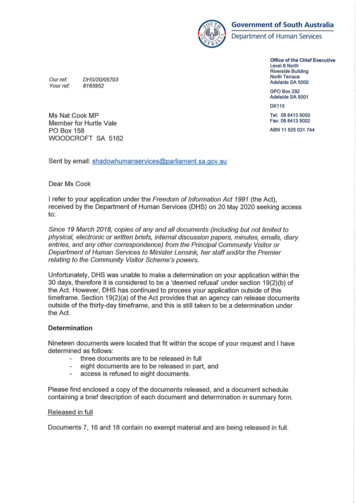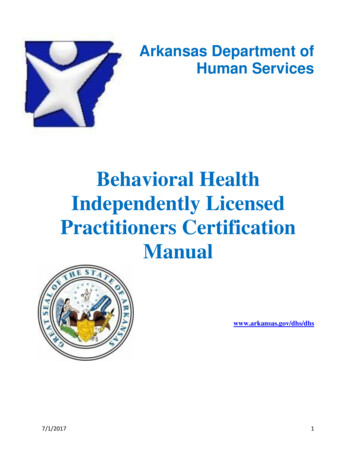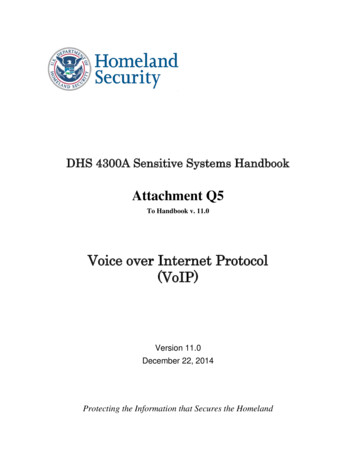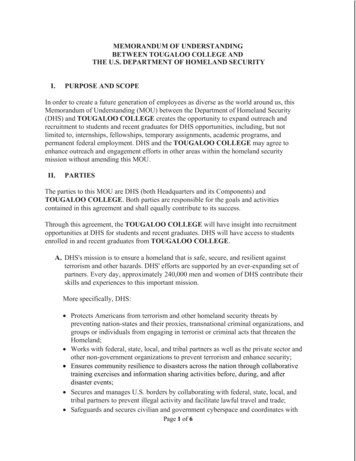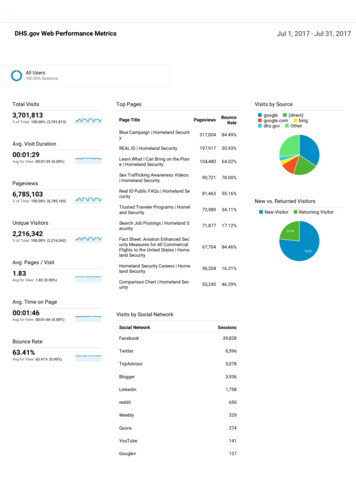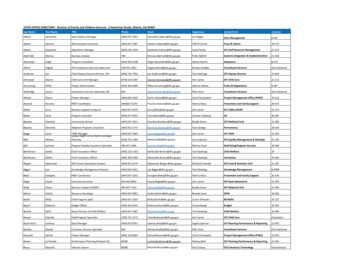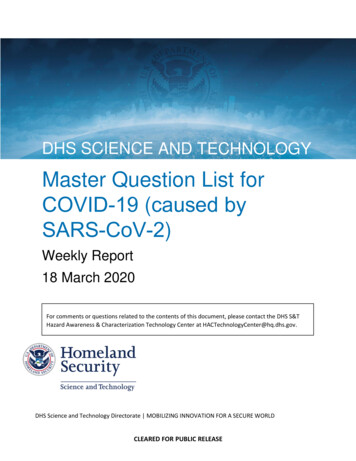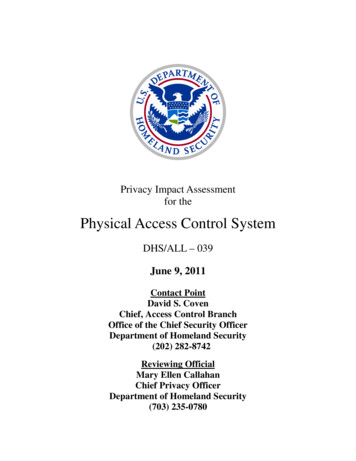
Transcription
Privacy Impact Assessmentfor thePhysical Access Control SystemDHS/ALL – 039June 9, 2011Contact PointDavid S. CovenChief, Access Control BranchOffice of the Chief Security OfficerDepartment of Homeland Security(202) 282-8742Reviewing OfficialMary Ellen CallahanChief Privacy OfficerDepartment of Homeland Security(703) 235-0780
Privacy Impact AssessmentDepartment of Homeland SecurityOffice of the Chief Security OfficerPhysical Access Control (PACS) System PIAPage 1AbstractThe Department of Homeland Security (DHS), Office of the Chief Security Officer (OCSO),Physical Access Control Division (PHYSD) operates the Physical Access Control System (PACS).PACS is a security technology integration application suite used to control and manage physical accessdevices, intrusion detection, and video surveillance at DHS Headquarters (HQ) facilities in the NationalCapital Region (NCR), primarily the Nebraska Avenue Complex (NAC). This PIA will focus exclusivelyon the physical access control and intrusion detection functions within PACS. The video surveillancefunction within PACS is covered by a separate PIA and can be found at www.dhs.gov/privacy. PACSprovides advanced access control, alarm monitoring, digital video,1 intrusion detection, and employee,visitor, and parking management.PACS allows authorized security personnel to simultaneously manage and monitor multiple entrypoints from a single, centralized location. The OCSO has conducted this Privacy Impact Assessment(PIA) to analyze the personally identifiable information (PII) that PACS collects, uses, and maintains. Tothe extent that other Departmental components use a system(s) that operates in the same way as PACSand will follow the rules outlined in this PIA, that system will be covered by this PIA and listed as part ofan update to this PIA appendix.OverviewPACS operates access control and intrusion detection functions at DHS HQ facilities in the NCR,primarily the NAC, and is comprised of a suite of applications which serve as a mechanism for themanagement of electronic access points and alarms. PACS produces automated transactional reports,documenting what activity took place, where and when.PACS applications used at DHS HQ facilities in the NCR, primarily the NAC, are divided intofour areas: A) identification for access; B) visitor management; C) parking permit management; D) alarmmonitoring and intrusion detection. All four applications and processes operate independently at thedirection of the PACS Administrator.A) Identification – PACS requires an individual’s PII so it can authorize physical access to DHSfacilities. PACS sensors read the information on an individual’s Personal Identity Verification (PIV) 2card to verify if the individual is authorized access.B) Visitor Management – Visitors and construction and service contractors 3 who have not beenissued a PIV card must be identified before being granted access. This is accomplished by having theindividual provide the information requested on DHS Form 11000-13 “Visitor Process Information.”OCSO personnel enter the information on the form into the PACS visitor management function. Thisinformation is then used to conduct a search of the National Crime Information Center (NCIC) todetermine if there are any criminal records or outstanding arrest warrants for the individual. The resultsof the NCIC check are entered into PACS. If there is no disqualifying information, such as an1See NAC CCTV PIA at www.dhs.gov/privacy.See PIVMS PIA and SORN at www.dhs.gov/privacy.3The facilities for which visitor information is maintained in PACS are: The Nebraska Avenue Complex, PlumbIsland, the S&T office in Arlington, VA, and the Saint Elizabeths complex.2
Privacy Impact AssessmentDepartment of Homeland SecurityOffice of the Chief Security OfficerPhysical Access Control (PACS) System PIAPage 2outstanding arrest warrant, the visitor is cleared for access. Access requests by foreign visitors 4 (non-U.S.citizens and non-Legal Permanent Residents) are processed through the DHS Foreign National VisitorManagement System (FNVMS). 5C) Parking Permit Management – The Office of the Chief Administrative Officer (OCAO) usesPACS to issue and track parking permits for the NAC. OCAO personnel access PACS to determine if anindividual is eligible to receive a parking permit. Once determined to be eligible, the individual mustsubmit General Services Administration (GSA) Parking Application, Form 2941. Upon issuance of theparking permit, OCAO personnel enter into PACS the name and e-mail address of the permit holder, thepermit number and type, issue date, and expiration date.D) Alarm Monitoring and Intrusion Detection – The PACS alarm monitoring application allowsOCSO personnel to monitor the Intrusion Detection System (IDS). A record is created in PACS of allIDS alarm activations or other issues, such as communication and power failures for example. The IDSin PACS consists of sensors, lights, and other mechanisms through which OCSO can detect theunauthorized intrusion of persons or devices. The only PII collected by the PACS IDS suite is the firstand last name of the individual authorized to turn the alarm system on and off and the corresponding PINnumber which the individual inputs into the alarm keypad to activate or deactivate the alarm.To the extent that other Departmental components use a system(s) that operates in the same wayas PACS and will follow the rules outlined in this PIA, that system will be covered by this PIA and listedas part of an update to this PIA appendix.Section 1.0 Authorities and Other Requirements1.1What specific legal authorities and/or agreements permitand define the collection of information by the project inquestion?The Chief Security Officer is responsible for developing and implementingsecurity policies, programs, and standards to protect and safeguard the Department'spersonnel, property, facilities, and information. To do this, the OCSO and PHYSD haveestablished access control policies designed to limit access to authorized individuals. Inorder to know if an individual is authorized access, the identity of the individual must beestablished. OCSO PHYSD does this by obtaining PII related to the individual and thenconducting appropriate checks of records maintained by DHS and other U.S. governmentagencies. Authorities associated with protecting federal property and informationinclude: 45 U.S.C. § 301, “Government Organization and Employees;”Executive Order 12977, “Interagency Security Committee;”The following information on foreign visitors to the NAC is maintained in PACS: Name, date of birth, andpassport or visa number.5See FNVMS PIA at www.dhs.gov/privacy.
Privacy Impact AssessmentDepartment of Homeland SecurityOffice of the Chief Security OfficerPhysical Access Control (PACS) System PIAPage 3 1.2Executive Order 13286, “Amendment of Executive Orders, and Other Actions, inConnection With the Transfer of Certain Functions to the Secretary of HomelandSecurity;”Presidential Decision Directive 12, “Security Awareness and Reporting of ForeignContacts;”Homeland Security Presidential Directive-7, “Critical Infrastructure Identification,Prioritization and Protection;”National Infrastructure Protection Plan, “Government Facilities Sector, SectorSpecific Plan;”Interagency Security Committee Standard, “Physical Security Criteria for FederalFacilities,” April 12, 2010; andFederal Property Regulations, July 2002.What Privacy Act System of Records Notice(s) (SORN(s))apply to the information?The following DHS SORNs apply: 1.3DHS/ALL – 024 Facility Access Control and Visitor Management, February 3, 2010,75 FR 5609.DHS/ALL – 023 Personnel Security Management Systems of Records, February 23,2010, 75 FR 8088.DHS/ALL – 026 Personal Identity Verification Management System, June 25, 2009,74 FR 30301.Has a system security plan been completed for theinformation system(s) supporting the project?A System Security Plan for PACS was completed on November 17, 2009, and asecurity certification authorizing the Authority to Operate (ATO) was granted on March22, 2010, by the DHS Information Systems Security Manager Certifying Official. TheATO will expire on March 21, 2013. The PACS Federal Information SecurityManagement Act (FISMA) ID is DHQ-03433-MAJ-03433.1.4Does a records retention schedule approved by theNational Archives and Records Administration (NARA)exist?DHS adheres to NARA General Records Schedule (GRS) 18, Security andProtective Services Records, items 20 through 25 for the retention schedule of personnelsecurity clearance records.In consultation with the DHS Records Officer, access control paper records aredestroyed within 60 days of being scanned into the Access Control Program Officesecured drive. The DHS visitor management paper records are destroyed not later than60 days after the information is entered into PACS. Currently, parking program paper
Privacy Impact AssessmentDepartment of Homeland SecurityOffice of the Chief Security OfficerPhysical Access Control (PACS) System PIAPage 4records are stored under lock and key in NAC Building 2. During the transition to thenew parking program, new records are stored under lock and key in NAC Building 7.Only designated parking or facilities personnel have access to documents in eitherlocation. Within 60 days after the information is entered into the parking portion ofPACS, the paper records are destroyed. Alarm monitoring and intrusion detectionincident longs are maintained for two years after final entry and then destroyed.1.5If the information is covered by the Paperwork Reduction0.Act (PRA), provide the OMB Control number and theagency number for the collection. If there are multipleforms, include a list in an appendix.OCSO is working with the PRA program management office to addressclearance requirements.Section 2.0 Characterization of the InformationThe following questions are intended to define the scope of the information requested and/orcollected, as well as reasons for its collection.2.1Identify the information the project collects, uses,disseminates, or maintains.PACS uses PII collected from individuals requiring access to confirm the identityof the individual and determine their access eligibility. PII is entered into PACS byOCSO personnel assigned to PHYSD or OCAO.The following data is collected and entered into PACS to identify individualsauthorized to access DHS HQ facilities in the NCR, primarily the NAC: Name;Social Security Number;Date of Birth;Gender;Home Address;Employee Type (e.g., Federal, Contractor, Detailee);Component;Home Agency or Company (if Detailee);Work Location;PIV Card – Number and Type; andPIV Card - Activation Date, Deactivation Date, and Pin Number.The following information is collected for visitor management purposes and is usedto verify the person entering the facility is suitable for access and does not have anoutstanding arrest warrant or pose a threat to individuals:
Privacy Impact AssessmentDepartment of Homeland SecurityOffice of the Chief Security OfficerPhysical Access Control (PACS) System PIAPage 5U.S. Citizen Visitors Name; Social Security Number; Access Level (how frequently the visitor accesses the facility); Expiration of the Visit Authorization; Date of Birth; Gender; Visitor Type; Visitor’s Home Agency or Company; Visit Type; DHS Point of Contact and Telephone Number; Office/Area Visited; Service Contractor Vehicle Information treated as separate visitor; If not service contract vehicle, vehicle information is listed in the visitor record:a. License number;b. Make of Vehicle;c. Model; andd. Color. Comments; Parking Pass Information categories; NCIC Completed Date; and Results of NCIC Check.Foreign Visitors Name; Date of Birth; Country; and Passport or Visa Number.The following information is collected by OCAO facilities managementpersonnel and is used to issue parking permits. The information is also used by OCAOfacilities management personnel to notify the individual in the event of an accident,emergency, or if their vehicle needs to be moved: Name;Vehicle Information (Make, Model, Color Year);Vehicle License Number and State of Registration;Parking Permit Number and Permit Issuance and Expiration Date;Permit Holder’s PIV Card Type; andPermit Holder’s e-mail address.
Privacy Impact AssessmentDepartment of Homeland SecurityOffice of the Chief Security OfficerPhysical Access Control (PACS) System PIAPage 62.2What are the sources of the information and how is theinformation collected for the project?For facility access purposes, the sources of PACS information are theindividual’s PIV card and DHS Form 11000-14, Identification Access Card ControlRequest.For visitor management purposes, the source of PACS information is DHS Form11000-13, Visitor Processing Information and information provided by foreign nationalvisitors.The information source for NAC parking permits is General ServicesAdministration (GSA) Form 2941.2.3Does the project use information from commercial sourcesor publicly available data? If so, explain why and how thisinformation is used.PACS does not use commercial or publicly available data.2.4Discuss how accuracy of the data is ensured.The information collected on DHS personnel and contractor employees isverified against information contained in the OCSO Integrated Security ManagementSystem (ISMS). 6 Information provided by visitors or parking permit applicants will notbe confirmed unless a situation develops that would cause OCSO to question theaccuracy of the information. Checks conducted on visitors are based upon theinformation provided by the visitor. DHS does not investigate the visitor to determine ifthe information provided by the visitor is valid.2.5Privacy Impact Analysis: Related to Characterization of theInformationPrivacy Risk: There is a risk associated with the accuracy of data included in thePACS. Although most of the PII data is generated by the individual, it is possible thatdata associated with individuals with the same name or similar names could beinaccurately entered.Mitigation: To address potential occurrences of data being inaccurately enteredthe following mitigation strategies are used: Electronic data collection tools are used tothe greatest extent possible and SSN is used to increase accuracy of subject identification.6See ISMS PIA at www.dhs.gov/privacy.
Privacy Impact AssessmentDepartment of Homeland SecurityOffice of the Chief Security OfficerPhysical Access Control (PACS) System PIAPage 7Section 3.0 Uses of the InformationThe following questions require a clear description of the project’s use of information.3.1Describe how and why the project uses the information.PACS uses PII in order to authenticate the identity of federal employees, DHScontractor employees, and visitors who are authorized entry. OCSO uses this informationto verify the identity of individuals and, in the event of an emergency, contact theindividual. PACS also contains information on vehicles for which a permanent parkingpermit has been issued or a daily permit for a vehicle carrying a visitor to the NAC.The IDS function within PACS monitors activity within sensitive or classifiedareas and records the name and pin number of the individual who activates or deactivatesan alarm.3.2Does the project use technology to conduct electronicsearches, queries, or analyses in an electronic database todiscover or locate a predictive pattern or an anomaly? Ifso, state how DHS plans to use such results.PII in PACS is used to manage access control, physical access devices, andintrusion detection at facilities. There are no in-build data analysis functions to identifypatterns or new areas of concern.3.3Are there other components with assigned roles andresponsibilities within the system?Only OCSO, OCAO, and the Office of the Chief Information Officer (OCIO)have assigned roles and responsibilities in PACS.3.4Privacy Impact Analysis: Related to the Uses ofInformationPrivacy Risk: There is a privacy risk associated with the handling of PII.Privacy risks associated with the handling of PII occur when data is extracted from thesystem and the individual using the data improperly distributes or stores the data.Privacy Risk: There is also a privacy risk associate with the system securityconcern of an “insider threat” where an individual authorized access to the systemconducts unauthorized activities, such as attempting to access information for which theydo not have permission.Mitigation: To address both of these risks the following controls and mitigationstrategies are in place:
Privacy Impact AssessmentDepartment of Homeland SecurityOffice of the Chief Security OfficerPhysical Access Control (PACS) System PIAPage 8Handling of PII Access to information is granted on a “need to know” basis; Access to PACS requires a DHS domain account and requires that the user be loggedinto a DHS Intranet accessible computer; PACS user accounts are individually approved by the Chief of the PHYSD; All users have received DHS computer security training and have been vetted and/orcleared for access to sensitive, and/or classified information; Access to PACS is role-based and users of the system have access to a limited subsetof data based on the concept of least privilege/limited access; and Write capability, which is limited to a few roles, is tracked and audited.System Security When information is stored as an attachment on the server, file access will berestricted by file permissions to prevent access by those without an appropriaterequirement for access; All automated data processing equipment supporting the application environment islocated in a DHS data center; Specific security roles have been defined and implemented within the application tocontrol access to information; A system security certification was performed and obtained in accordance with theOffice of Management and Budget (OMB) Circular A-130, Appendix III, Security ofFederal Automated Information Resources; and Network access to the application is made via a Secure Sockets Layer (SSL)connection to the ISMS environment.Section 4.0 NoticeThe following questions seek information about the project’s notice to the individual about the informationcollected, the right to consent to uses of said information, and the right to decline to provide information.4.1How does the project provide individuals notice prior to thecollection of information? If notice is not provided, explainwhy not.Individuals are provided notice at the time of collection by a Privacy Act Noticeon the bottom of the information collection form. The Privacy Act Notice explains thereasons for collecting information, the consequences of failing to provide the requestedinformation, and how the information is used. The collection, maintenance, anddisclosure of information complies with the Privacy Act as noted in DHS/ALL – 023Personnel Security Management, January 16, 2009, 74 FR 3084; DHS/ALL – 024Facility and Perimeter Access Control and Visitor Management, January 16, 2009, 74 FR3081; and DHS/ALL – 026 Personal Identity Verification Management System,September 25, 2009, 74 FR 30301.Visitors to the NAC must agree with the Privacy Act Statement provided at thetime the visitor is processed for access to the NAC.
Privacy Impact AssessmentDepartment of Homeland SecurityOffice of the Chief Security OfficerPhysical Access Control (PACS) System PIAPage 94.2What opportunities are available for individuals to consentto uses, decline to provide information, or opt out of theproject?Employees and contractor employees who opt not to provide information will notbe granted access to DHS facilities since PACS will not have the ability to manage theelectronic access points and alarms through which they must pass.Visitors are advised that access control procedures require the submission of theirPII. They are also advised that DHS will use this information to determine if access maybe granted and that failure to furnish the requested information may delay or prevent theiraccess.4.3Privacy Impact Analysis: Related to NoticeInformation collected in association with the DHS PIV card, and used to manageaccess control within PACS, is completed in accordance with federal personnel securitystandards and requirements.Visitors and foreign national visitors from whom data is collected may use arepresentative, (e.g., Executive Assistant or Embassy staff) to provide the data.Accordingly, there is a risk that the representative may not convey the Privacy Act Noticeexplaining why DHS is requesting the information and how the information will be usedand stored. This PIA serves as an additional notice as well as a further explanationregarding the way DHS receives and manages PACS data. Notice is also providedthrough DHS/ALL – 024 Facility and Perimeter Access Control and VisitorManagement, January 16, 2009, 74 FR 3081.Section 5.0 Data Retention by the projectThe following questions are intended to outline how long the project retains the information after the initialcollection.5.1Explain how long and for what reason the information isretained.DHS personnel and security records relating to individuals are retained anddisposed of in accordance with GRS 18, item 22a and 22c, as approved by NARA.Records are destroyed upon notification of death or not later than five years afterseparation or transfer of the employee, whichever is first. The index to personnel securitycase files are destroyed with the related case.Visitor records are retained in accordance with GRS 18, Item 17 and aredestroyed five years after final entry or five years after the date of the document, asappropriate.
Privacy Impact AssessmentDepartment of Homeland SecurityOffice of the Chief Security OfficerPhysical Access Control (PACS) System PIAPage 10Where records are used as evidence in an investigation or in an administrative,litigation, or other proceeding, the records will be retained until final disposition of theinvestigation or proceeding.5.2Privacy Impact Analysis: Related to RetentionRisks associated with the retention and disposal of records collected in PACS areminimal. Risk is present when information for PACS is provided on paper form by theapplicant. The risk is mitigated by security procedures in handling the data anddestroying the files in accordance with the GRS.Section 6.0 Information SharingThe following questions are intended to describe the scope of the project information sharing external tothe Department. External sharing encompasses sharing with other federal, state and local government, and privatesector entities.6.1Is information shared outside of DHS as part of the normalagency operations? If so, identify the organization(s) andhow the information is accessed and how it is to be used.Information contained in PACS for access management purposes is not sharedoutside of DHS as part of the normal agency operations.Visitor management information is shared outside PACS as part of normaloperations for conducting record checks on the individual with other U.S. governmentagencies. The U.S. government agency to which the information is sent uses theinformation to search its records for information about the individual. Each agencymaintains its records in accordance with its privacy policies. Some record checks areconducted with U.S. government agencies that maintain national security systemsconsistent with the requirements of Executive Order 12333, as amended, “United StatesIntelligence Activities.”6.2Describe how the external sharing noted in 6.1 iscompatible with the SORN noted in 1.2.Routine uses of records in PACS associated with visitors accessing DHSfacilities are addressed in DHS/ALL – 023 Personnel Security Management, January 16,2009, 74 FR 3084; DHS/ALL – 024 Facility and Perimeter Access Control and VisitorManagement, January 16, 2009, 74 FR 3081; and DHS/ALL – 026 Personal IdentityVerification Management System, September 25, 2009, 74 FR 30301.6.3Does the project place limitations on re-dissemination?No limitations are placed on re-dissemination of information within DHS as long
Privacy Impact AssessmentDepartment of Homeland SecurityOffice of the Chief Security OfficerPhysical Access Control (PACS) System PIAPage 11as there is an official need to know.6.4Describe how the project maintains a record of anydisclosures outside of the Department.PACS contains a field which maintains a record of the type of check conductedon the visitor as well as the agency with which it was conducted.6.5Privacy Impact Analysis: Related to Information SharingPrivacy Risk: As discussed in Section 3.4, there is the potential for an individualauthorized to access the system to conduct unauthorized activities such as attempting toaccess information or extracting and sharing information for which they do not havepermission.Mitigation: To address this risk the following controls are in place: A data/report request form must be completed, signed, and approved by the requester,requester’s manager, and their Division Chief prior to the creation and/or distributionof personnel security data to avoid accidental, inappropriate, or unauthorized use ofthe data;Access to information is granted on a “need to know” basis;Access to FNVMS requires a DHS domain account and requires that the user belogged into a DHS Intranet accessible computer;FNVMS user accounts are individually approved by OCSO and the Chief of ISID;All users have received DHS computer security training and have been vetted and/orcleared for access to privacy, sensitive, and/or classified information;Access to FNVMS is role-based and users of the system have access to a limitedsubset of data based on the concept of least privilege/limited access; andWrite capability is limited to a few roles and is tracked and audited.Section 7.0 RedressThe following questions seek information about processes in place for individuals to seek redress whichmay include access to records about themselves, ensuring the accuracy of the information collected about them,and/or filing complaints.7.1What are the procedures that allow individuals to accesstheir information?Once data is submitted to OCSO for entry in PACS the individual who submittedthe information must contact OCSO directly or submit a Privacy Act (PA) or Freedom ofInformation Act (FOIA) request to gain access to their PII and request that it becorrected. Individuals have the ability to address and provide updated information.OCSO may be contacted through its Customer Service Center at 202-447-5010 or byemail at officeofsecurity@hq.dhs.gov.
Privacy Impact AssessmentDepartment of Homeland SecurityOffice of the Chief Security OfficerPhysical Access Control (PACS) System PIAPage 127.2What procedures are in place to allow the subjectindividual to correct inaccurate or erroneous information?OCSO will make changes to employee and contractor employee PACS records aslong as the information is consistent with information ISMS. Changes will be made tovisitor records if the change requested can be verified.7.3How does the project notify individuals about theprocedures for correcting their information?Instructions are provided on the respective form for making changes or updatesto data that may be necessary after original submission. If an individual needs to makechanges to enhance the accuracy of the information, the individual may contact OCSOthrough its Customer Service Center at 202-447-5010 or by email atofficeofsecurity@hq.dhs.gov.7.4Privacy Impact Analysis: Related to RedressInformation contained in PACS may be corrected by contacting OCSO throughits Customer Service Center at 202-447-5010 or by email at officeofsecurity@hq.dhs.govor through redress procedures afforded under the PA and FOIA.Section 8.0 Auditing and AccountabilityThe following questions are intended to describe technical and policy based safeguards and securitymeasures.8.1How does the project ensure that the information is used inaccordance with stated practices in this PIA?All PACS user access is based on pre-defined system owner and managementauthorized job roles and official duties. These roles and policies are enforced through useof access control lists. As such, PACS users may only input, update, and delete recordsor fields to which they are authorized to have access and a need-to-know, as prescribedby the application user manual and system administration procedures.Additionally, access control software on PACS prevents users from having all ofthe necessary authority or information access to perform fraudulent activity withoutcollusion.8.2Describe what privacy training is provided to users eithergenerally or specifically relevant to the project.All DHS employees and assigned contractor staff receive privacy and securitytraining, and have undergone necessary suitability investigations and/or received security
Privacy Impact AssessmentDepartment of Homeland SecurityOffice of the Chief Security OfficerPhysical Access Control (PACS) System PIAPage 13clearances for access to classified national security information and facilities.Additionally, standard operating procedures and system user manuals describe in detailuser responsibilities and training requirements.8.3What procedures are in place to determine which usersmay access the information and how does the projectdetermine who has access?PACS user accounts are individually approved by the OCSO PHYSD, AccessControl Branch Chief, and authorized by the Chief of the Systems Security Division. Allusers must have received DHS computer security training and have been vetted for accessto DHS IT systems or for access to classified national security information. Furthermore,access to PACS is role-based and users of the system have access to a limited subset ofdata based on the concept of least privilege/limited access.
Privacy Impact AssessmentDepartment of Homeland SecurityOffice of the Chief Sec
Physical Access Control (PACS) System PIA Page 1 Abstract The Department of Homeland Security (DHS), Office of the Chief Security Officer (OCSO), Physical Access Control Division (PHYSD) operates the Physical Access Control System (PACS). PACS is a security technology integration application suite used to control and manage physical access
